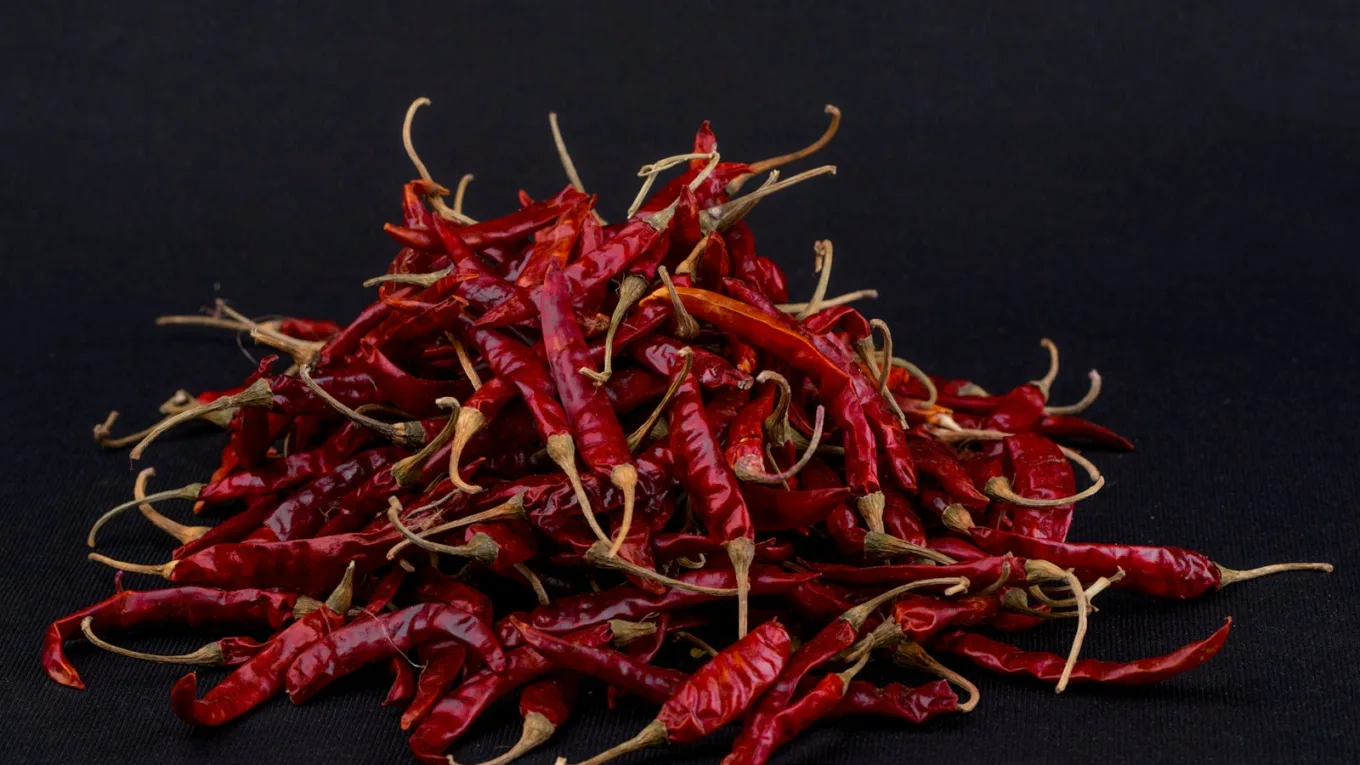The What, Why and Where of Chili peppers!
Chili peppers, belonging to the genus Capsicum, are a diverse and vibrant family of fruits that have left an indelible mark on global cuisines. These peppers come in a plethora of varieties, ranging from the mild sweetness of bell peppers to the fiery intensity of habaneros and ghost peppers. Central to their allure is capsaicin, the compound responsible for their heat, measured on the Scoville Heat Scale.

Culinary Prowess:
Chilies are culinary powerhouses, finding a place in an array of dishes worldwide. Mexican cuisine revels in the smoky richness of chipotle, while Indian curries burst with the warmth of varieties like the bhut jolokia. Fresh, dried, or ground into powders like cayenne, chilies contribute not only heat but also distinctive flavors to salsas, stews, sauces, and more.
Nutritional Bounty:
Beyond their culinary appeal, chili peppers offer a nutritional bounty. They are rich in vitamins, particularly vitamin C, and provide a dose of antioxidants. The reputed health benefits of capsaicin include potential pain relief, leading to its use in topical analgesic creams.
Cultural Significance:
Chilies hold cultural significance, often playing a starring role in festivals and events around the globe. Competitions to determine the hottest pepper showcase the passion and enthusiasm that chili lovers bring to their appreciation of these spicy wonders.
Global Cultivation:
Chilies thrive in warm climates, and their cultivation spans the globe. Leading producers like China, India, and Mexico contribute to the rich tapestry of flavors available in the international spice market. Whether grown as annuals or perennials, chilies find a home in gardens and fields, adding color and spice to landscapes.
Dried and Smoked Varieties:
Chili peppers undergo diverse transformations, with some varieties taking on new dimensions when dried or smoked. Chipotle peppers, made from smoked jalapeños, and ancho peppers, derived from dried poblanos, exemplify the depth and complexity that these processes impart.
Medicinal and Culinary Fusion:
The medicinal and culinary worlds converge in chili peppers. Their purported health benefits are complemented by their versatility in the kitchen, where they are stuffed, grilled, pickled, or used to create piquant hot sauces. This fusion of the medicinal and culinary realms underscores the multi-faceted nature of chili peppers.
Chili peppers, beyond their fiery flavor, offer a range of health benefits, making them a valuable addition to diets around the world.
1. Rich in Vitamins and Minerals: Chilies are abundant in essential nutrients, particularly vitamin C, which supports the immune system, and vitamin A, crucial for vision and skin health. They also contain minerals like potassium, which is important for heart health.
2. Antioxidant Properties: Chili peppers boast antioxidant compounds that help combat oxidative stress in the body. These antioxidants contribute to overall health by neutralizing free radicals, which can play a role in various chronic diseases.
3. Metabolism Boost: The capsaicin in chili peppers has been associated with a temporary increase in metabolism. This thermogenic effect may aid in weight management by promoting calorie burning and fat oxidation.
4. Pain Relief and Anti-Inflammatory Effects: Capsaicin, the active component in chili peppers, has analgesic properties. It is used topically in creams and patches to alleviate pain associated with conditions like arthritis and neuropathy. Capsaicin may also have anti-inflammatory effects.

5. Cardiovascular Health: Chilies may contribute to cardiovascular health by promoting a healthy lipid profile. They have been linked to lower levels of bad cholesterol (LDL) and triglycerides in some studies.
6. Blood Sugar Regulation: Some research suggests that chili consumption may help regulate blood sugar levels, potentially benefiting individuals with or at risk of type 2 diabetes. Capsaicin may play a role in improving insulin sensitivity.
7. Respiratory Health: The heat from chili peppers can act as a natural decongestant, helping to alleviate nasal congestion and promote better respiratory function. Spicy foods are often used to clear sinuses.
8. Mood Enhancement: Consuming chili peppers can trigger the release of endorphins, the body’s natural feel-good chemicals. This may contribute to a sense of well-being and happiness, commonly referred to as the “spicy food high.”
9. Culinary Versatility: Beyond their health benefits, chilies enhance the flavor and palatability of dishes, encouraging the use of fresh, whole foods. Their versatility makes them a staple in various cuisines, adding depth and complexity to meals.
10. Cultural Significance: Chilies hold cultural importance in many societies, often featuring in traditional remedies and celebrations. The cultural significance adds to their global appeal and enduring popularity.
Chili peppers thrive in warm climates with well-drained soil and plenty of sunlight. They are typically grown in temperatures ranging from 70°F to 90°F (21°C to 32°C). While they are adaptable to various conditions, a frost-free environment is essential for successful cultivation. Many of the top chili-producing countries are situated in regions with warm and sunny climates.
Top 5 Countries Producing Chili:

- China: China leads the world in chili production, cultivating a diverse array of chili varieties. The country’s vast and varied landscapes provide ideal conditions for chili cultivation. Chinese cuisine heavily incorporates chili peppers, contributing to the nation’s significant role in the global chili market.
- India: India is a major player in chili production, known for its cultivation of various spicy pepper varieties. The warm and tropical climate in many regions of India supports the growth of chilies. Chilies are integral to Indian culinary traditions, featuring prominently in dishes across the country.
- Mexico: Mexico is renowned for its rich culinary heritage, and chili peppers are at the heart of many traditional dishes. The country’s diverse climates, from arid to tropical, offer suitable conditions for cultivating a wide range of chili varieties. Mexican chilies, both fresh and dried, contribute to the country’s global influence in the spice trade.
- Thailand: Thailand’s tropical climate provides an excellent environment for chili cultivation. Thai cuisine is famous for its vibrant and spicy flavors, with chili peppers playing a central role. Thailand’s contribution to the global chili market reflects its cultural reliance on these fiery peppers.
- Indonesia: Indonesia is a significant producer of chili peppers, benefitting from its tropical climate. Chilies are widely used in Indonesian cuisine, adding heat and flavor to many dishes. The country’s diverse agricultural landscape supports the cultivation of various chili varieties.

Chili peppers stand as more than just a culinary delight; they embody a global fusion of flavors, cultures, and health benefits. Thriving in warm climates, these vibrant fruits have found their way into the hearts of farmers and chefs across the world. From China’s diverse chili varieties to India’s spicy culinary tapestry, Mexico’s rich pepper traditions, Thailand’s tropical heat, and Indonesia’s chili-infused dishes, these top chili-producing nations shape the global spice market.
Beyond their fiery reputation, chilies offer a nutritional bounty, contributing essential vitamins, antioxidants, and potential health perks. The capsaicin they contain not only ignites taste buds but also holds promise for pain relief, metabolism boost, and more.
Chilies are not just ingredients; they’re cultural symbols, playing pivotal roles in festivals, traditional remedies, and daily meals. Whether fresh, dried, or ground into powders, their versatility in the kitchen knows no bounds. The journey of chili peppers, from the sun-soaked fields of their cultivation to the sizzling pans of kitchens worldwide, illustrates their profound impact on our palates, health, and the global spice trade.
As we savor the diverse flavors and cultural significance of chili peppers, it’s a reminder that these little fruits pack more than just heat—they encapsulate a world of culinary exploration, cultural richness, and a shared love for the spice of life.







